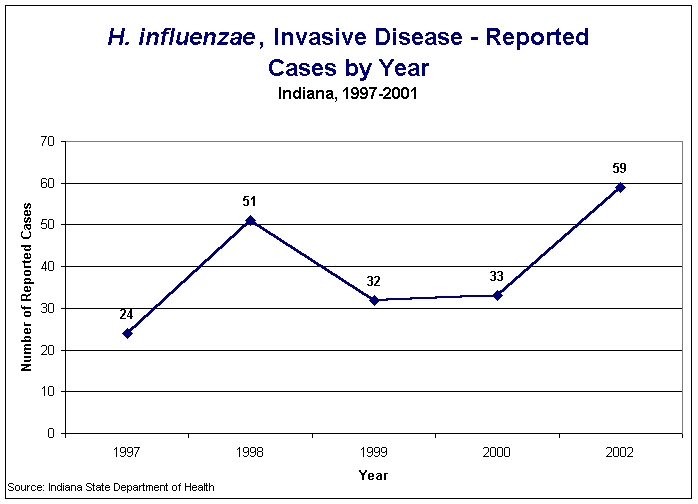Figure Hi1: H. influenzae, Invasive Disease - Reported Cases by Year, Indiana, 1997-2001

2001 Indiana Report of Infectious Diseases |
View CDC's Haemophilus influenzae infection page
Rates presented are per 100,000 population and are based on the U.S. 2000 Census.
| Cases | Incidence Rate |
|
| Total | 59 | 1.0 |
| Race-specific cases and rates1 | ||
| White | 53 | 1.0 |
| Black | 4 | 0.8* |
| Other2 | 0 | |
| Sex-specific cases and rates | ||
| Female | 30 | 1.0 |
| Male | 29 | 1.0 |
Indiana had 59 reported cases of invasive Haemophilus influenzae disease in 2001, the highest number of reported cases in one year during the five-year period 1997-2001 (Figure Hi1). Those with reported cases ranged in age from newborn to 100 years, with a median age of 62 and a mean age of 55. Eight of the cases were in those under age 5. There were no significant differences in the incidence of invasive H. influenzae disease between the sexes or racial groups. The age-specific incidence rate was highest in the less those under age 1 (7.1), but was also higher among the elderly (Figure Hi2). The majority of cases (50.8%) presented with bacteremia with no other type of infection, while other presentations were less common. Table Hi1 shows the most commonly reported presentations.
One case was serotyped as type b, the only type preventable by vaccine. The type b case occurred in a 65-year-old individual and, thus, was not preventable by vaccine, as Haemophilus influenzae type b (Hib) is given only to persons under age 5. Table Hi2 presents a breakdown of cases by serotype.
As the table indicates, of the 59 cases of invasive H. influenzae disease reported in 2001, 11 (18.6%) isolates were not serotyped. Additionally, one of the eight cases in those under age 5 was not serotyped. Because Hib vaccines protect against type b and no other strains of Haemophilus influenzae (Hi) serotypes, serotyping of all Hi isolates from patients with invasive disease is necessary to monitor vaccination program effectiveness and national progress towards Hib elimination. Serotype information is also needed to measure the sensitivity of the surveillance system and to detect the emergence of invasive disease from nontype b Hi strains.
Prior to the licensure of Hib vaccine, Hib disease was the leading cause of bacterial meningitis in children. Since the introduction of conjugate Hib vaccine in 1990, the incidence of Hib disease in children has decreased dramatically in the U.S. and Indiana. From 1997-2001, the mean number of Hib cases reported in Indiana among children ages 5 and under is 1.2 cases per year.
Back to Top of Article
Back to Table of Contents
|
Figure Hi1: H. influenzae, Invasive Disease - Reported Cases by Year, Indiana, 1997-2001 |
|
|
Back to Reference in Text
Back to Top of Article
|
Figure Hi2: H. influenzae, Invasive Disease - Incidence Rates by Age Group, Indiana, 2001 |
|
|
Back to Reference in Text
Back to Top of Article
Back to Reference in Text
Back to Top of Article
|
Table Hi2: H. influenzae, Invasive Disease - Percent of Reported Cases by Serotype, Indiana, 2001 |
||||||||||||||||||||||||||||||||||||
|
||||||||||||||||||||||||||||||||||||
Back to Reference in Text
Back to Top of Article
1 - Race was unknown for 2 of the reported cases.
2 - "Other" includes American Indian/Alaska Native, Asian, Native Hawaiian/Pacific Islander, and multiracial.
* - Rate based on less than 20 cases and should be considered unstable.
Back to Table of Contents
[an error occurred while processing this directive]